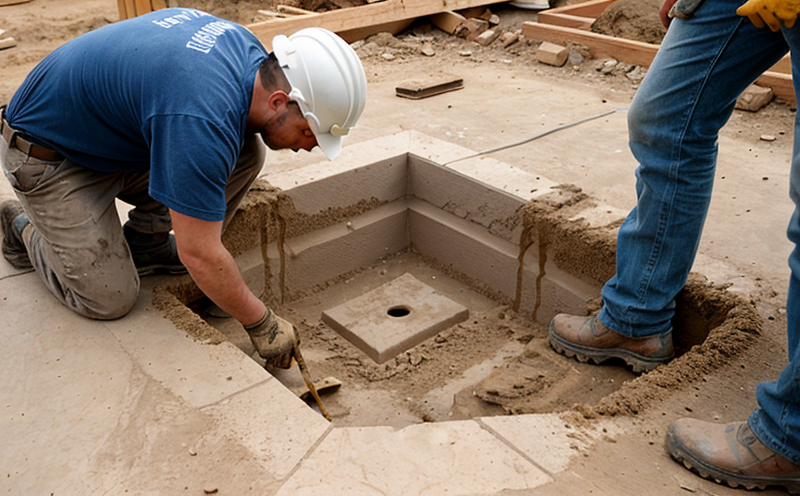Foundation footing inspection
The foundation footing is a critical component in any construction project. It provides stability and support to the structure, ensuring that it can withstand the forces exerted by the building itself as well as external factors such as wind, rain, and seismic activity. The integrity of these footings is paramount because they are often the first line of defense against structural failure.
Inadequate foundation footing design or construction can lead to severe consequences including structural collapse, water infiltration, uneven settlement, and compromised durability over time. Therefore, thorough inspection is essential to ensure compliance with local building codes and standards, as well as to safeguard the safety and long-term performance of the structure.
The inspection process typically involves a series of non-destructive testing (NDT) methods and visual assessments aimed at identifying potential flaws or issues before they escalate. Common tools used in this process include ground-penetrating radar (GPR), electromagnetic induction (EMI) devices, ultrasonic testers, and traditional excavation methods for detailed examination.
During the inspection, it is crucial to evaluate the type of footing used—whether it's a continuous footing, isolated footings, or spread footings—and assess their dimensions and materials. The integrity of concrete, grout, sand, and any other fill materials must also be verified. This includes checking for cracks, voids, segregation, and insufficient reinforcement.
The quality assurance standards that guide this process are typically based on international norms such as ISO 19286-2:2015 or ASTM D4337. These standards provide the framework for acceptable limits of defects and imperfections in concrete structures. Compliance with these guidelines ensures that the foundation footing meets the necessary strength, durability, and stability requirements.
It is also important to consider environmental factors such as soil type, moisture content, and temperature variations when conducting inspections. Soil conditions can significantly influence the design and performance of a foundation footing, making it essential to account for these variables during inspection.
The findings from the inspection are documented in comprehensive reports that detail any observed issues along with recommendations for corrective actions if necessary. These reports serve as vital references for future maintenance and repairs, helping ensure ongoing structural integrity over the lifespan of the building.
Why It Matters
The importance of foundation footing inspection cannot be overstated given its critical role in ensuring the overall stability and safety of a construction project. A robust inspection process helps identify potential problems early on, preventing costly repairs down the line. By adhering to strict quality assurance protocols, builders can demonstrate compliance with regulatory requirements, thereby enhancing their reputation and credibility within the industry.
Moreover, regular inspections contribute to sustainable building practices by promoting longevity and energy efficiency in structures. Structures built on sound foundations are less likely to suffer from premature deterioration or collapse incidents, which not only protects occupants but also conserves resources used in construction materials and labor.
The economic benefits of thorough foundation footing inspection extend beyond immediate savings; they include reduced insurance premiums due to lower risk profiles associated with well-maintained buildings. Additionally, there is a positive environmental impact since less frequent rebuilding reduces waste generation and energy consumption during new construction phases.
Quality and Reliability Assurance
- Data Collection: Accurate data collection is fundamental to reliable inspection outcomes. This includes precise measurements of dimensions, material composition analysis, and recording the presence or absence of defects.
- Non-Destructive Testing Methods: Utilizing advanced NDT techniques allows for detailed examination without causing damage to the structure being inspected.
- Documentation: Comprehensive documentation ensures that all inspection results are accurately recorded and easily accessible for future reference or review.
The use of these methods helps maintain consistency in inspections, ensuring that each project adheres strictly to specified standards. This approach fosters trust among stakeholders, including clients, regulators, and the general public.
Competitive Advantage and Market Impact
Offering comprehensive foundation footing inspection services positions a laboratory as a leader in quality assurance and compliance within the construction sector. By providing detailed reports that meet or exceed industry standards, laboratories can attract more clients seeking reliable service providers who understand their specific needs.
This expertise also enhances market visibility through word-of-mouth referrals and repeat business from satisfied customers. Moreover, participating in certifications relevant to foundation inspections adds value for both suppliers and end-users of construction products and services.
The demand for such specialized services is expected to grow as sustainability becomes increasingly important across various industries. Construction projects that prioritize quality assurance not only meet regulatory requirements but also contribute positively towards reducing carbon footprints and promoting sustainable development goals.





